
Preventing and relieving backache
Backaches are extremely common. At least one in two people will suffer from them at some point in their life. In fact, a backache is not actually a disease: it is a symptom. It is often caused by a trauma or microtrauma affecting a disk (herniated disk), ligament (sprain), muscle (tear), or nerve (neuralgia) in the lumbar region. Many factors can trigger a backache: an awkward movement, improper handling of a heavy object, bad posture, repetitive work, fatigue, stress, weak back or abdominal muscles, being overweight, pregnancy, aging (arthrosis of the spinal column or osteoporosis), etc. Simple tricks can help to relieve or prevent backaches.
Preventing backache
Do physical exercise
Breathe
Relax and breathe correctly, that is, slowly and from the abdomen. Stress and tension contribute to backache.
Lift objects correctly
Avoid sleeping on your stomach or on an overly soft mattress
Move
Wear comfortable shoes
Maintain good posture
Participate in moderate physical activities on a regular basis. In particular, strengthen your back and abdominal muscles by means of warm-up, stretching, and body-building exercises. Here are a few simple exercises that you can do every day to prevent backaches:
Knees to chestLie down on your back and bring your thighs up to your abdomen. Wrap your arms around your legs. Breathe deeply.
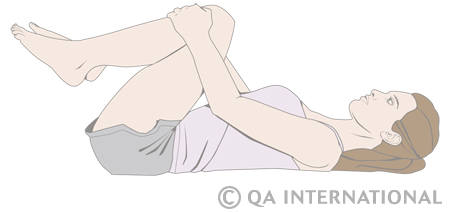
Cat position
Get on your hands and knees, with your hands aligned straight below your shoulders and your knees apart. Breathe in and slowly arch your back while raising your head. Breathe out and slowly round your back while lowering your head and stretching your arms. Repeat these movements 5–10 times.
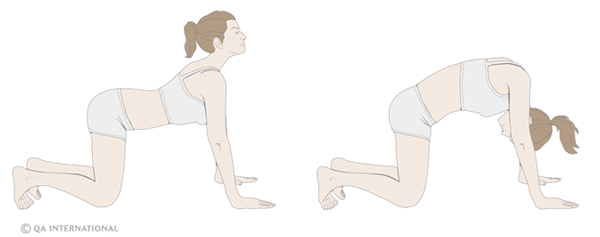 Raised pelvis
Raised pelvis
Lie down on your back and bend your knees, placing your feet close to your pelvis and slightly apart. Raise your pelvis, keeping your upper body on the ground. Hold this position for at least 30 seconds, breathing deeply.
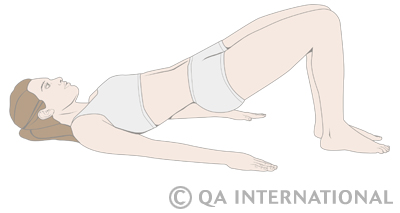
Abdominals
Lie down on your back, fold your arms over your chest and bend your knees, keeping your feet flat on the ground. Contract your abdominal muscles and slowly raise your shoulders, keeping your head in alignment with the rest of your body. Hold this position for 1 or 2 seconds, then slowly lower your shoulders back down. Repeat this 5–10 times.
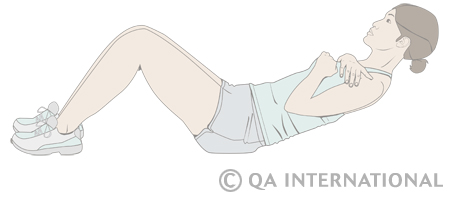
Avoid carrying overly heavy loads, and lift objects by bending your knees and keeping your back straight, with the items held close to your body. Do not twist your back suddenly or awkwardly. Use your leg muscles, not your back muscles.
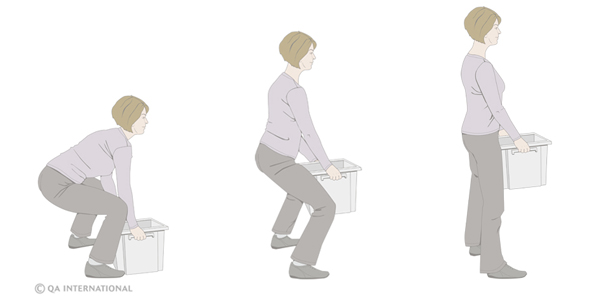
Walk and stretch regularly. Avoid standing or sitting for extended periods of time.
Maintain good posture, especially at work and behind the wheel of your car: back and head held straight, elbows naturally bent. Your work chair and the seat of your car should provide support to your lower back (add an orthopedic support, if needed).
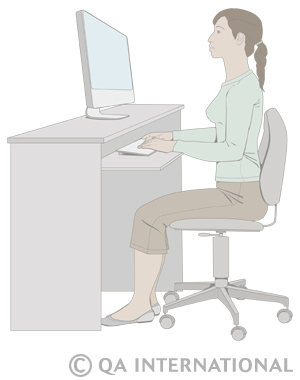
Relieving backaches
Stop the activity that triggered the pain
Soothe the pain
Apply cold, then heat
Lie down on a hard surface
Do not stay in bed
Soothe the pain by means of anti-inflammatories or analgesics if your state of health allows, and be sure to follow the dosage indicated.
During the first 48 hours, apply cold to the pain, to reduce the inflammation, in alternating periods of 15 minutes with, then without, ice. After 48 hours, apply heat to the painful area, to relax the muscles and encourage healing.
Lie down on your back, either directly on the floor or on a firm mattress, with a pillow under your knees. If you have major pain, you can stay lying down, although it is preferable to try to get up and walk around for a few minutes every hour.
Do not stay in bed more than two or three days. As soon as you can, do moderate exercise like walking, cycling, or swimming.
Warning! Talk to a doctor if you have major pain or if the pain persists.
Also see:
In the Visual Dictionary:
- "skeleton" section
- "muscles" section
- "sports and games" section
In the encyclopedic capsules :




